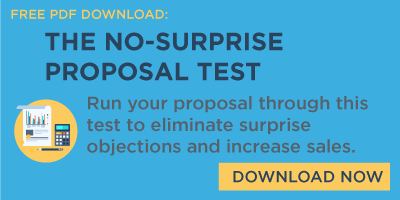
1. They don’t hear “yes” often enough.
2. They don’t hear “no” often enough.
When you talk to salespeople all time as I do, it’s easy to see the biggest problem with many proposals is that they seem to fall into a black hole, an abyss, where salespeople don’t hear either "yes" or "no." That’s a problem.
It’s better to hear “no” than nothing. As a result, salespeople feed pending information to their managers each week, which includes proposals still hanging out there, and sales managers continue to miss their projections with faulty data. Experience shows that each week that goes by between presentation and getting an answer, the chance of closing a proposal goes down. In fact, the closing percentage on proposals over 30 days old is usually less than 10%, far less than what the salespeople are projecting. The reality is a no answer is usually a “no” answer.
So, how can salespeople avoid having their proposals drop off the face of the planet, never to be heard about again? Here are some steps that should be useful:
1. Look at your proposal (or have someone else less emotionally connected do it).
What percentage of the language is "boilerplate" from your shared proposal drive, and what percentage was written specifically for this prospect? I see hundreds of generic proposals hastily assembled from shared drives, and most of those proposals deserve to be ignored because they look like everyone else’s graphically-rich, generic pitch pages.
2. What problem is your proposal looking to solve?
Is there a problem or unrealized opportunity the prospect identified in your conversations? If so, your chances are much better. Does your proposal look to solve a problem (like needing to sell more stuff)? If your conversations with this prospect have revealed an area where they are anxious for a solution, your proposal won’t be ignored. However, if only you are the anxious party in the mix, expect to be ignored.
3. Don’t prepare a proposal too soon.
The only time to build a proposal is after everyone has agreed on the problem or issues the prospect needs to address, you have confirmed those needs, you have run several ideas past the prospect and he/she has chosen the ones with potential, and after you have trial ballooned a price range. In other words, by the time your prospect gets a proposal from you, there should be no surprises, as they know most of what will be in it (because they had a hand in shaping it) and about how much it would cost (they are not shutting down due to sticker shock). The proposal is more a confirmation of the items you have agreed upon and what the specific implementation will look like. When presenting the proposal you will, or course, ask for the order. But, think about how much more likely they are to say “yes” to something they helped build after you have been closing on every step of the process? You know the answer.
If you are hearing, “I need to think about this," or worse yet, you are hearing nothing, try these ideas. Premature, generic proposals are everywhere today which is why too many proposals simply die of old age, not rejection.



